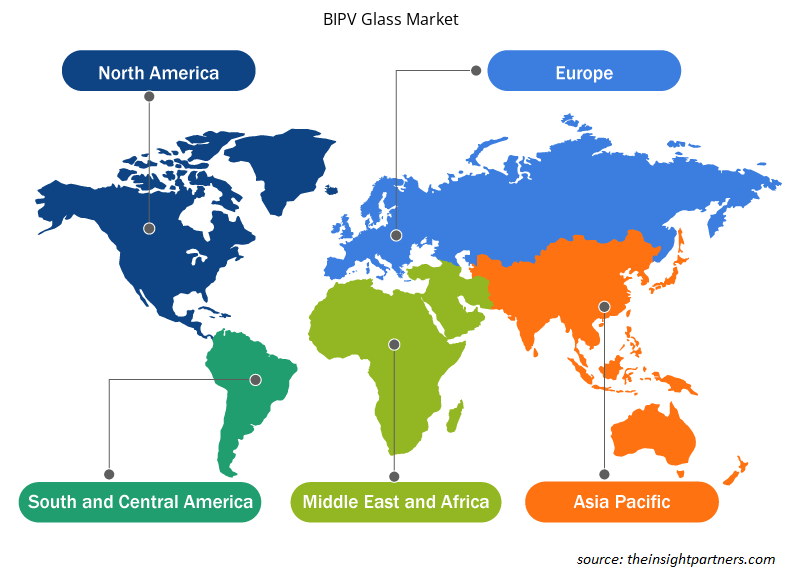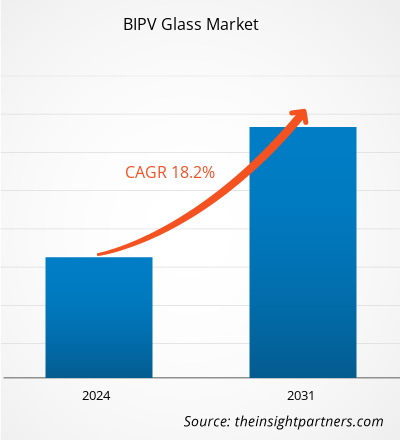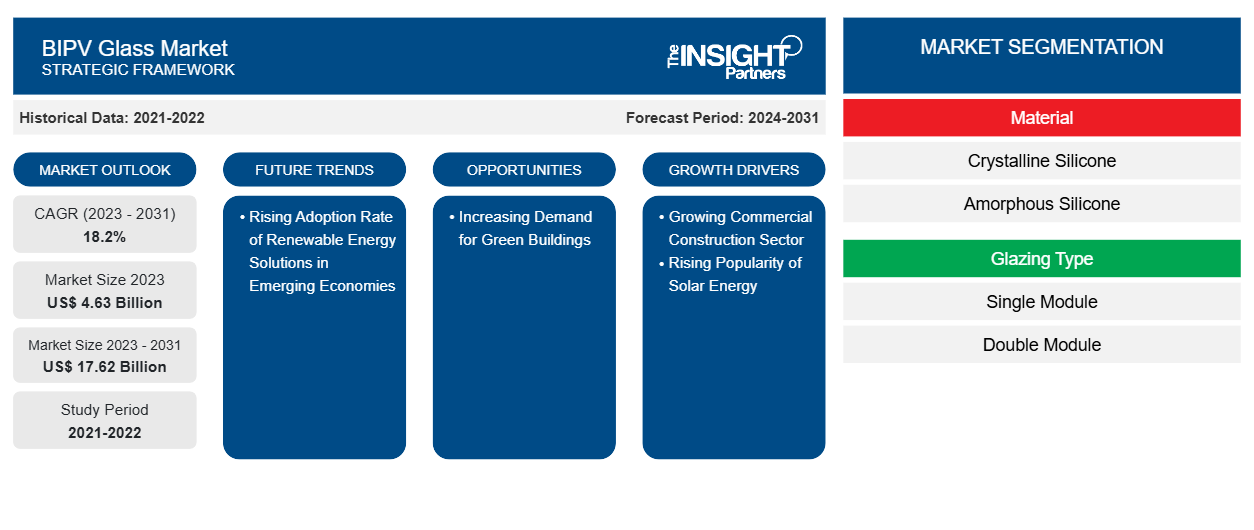Der Markt für BIPV-Glas soll von 4,63 Milliarden US-Dollar im Jahr 2023 auf 17,62 Milliarden US-Dollar im Jahr 2031 wachsen; für den Zeitraum von 2023 bis 2031 wird eine durchschnittliche jährliche Wachstumsrate (CAGR) von 18,2 % erwartet.
Der globale BIPV-Glasmarkt hat in den letzten Jahren ein bemerkenswertes Wachstum erlebt, das durch die steigende Nachfrage aus dem gewerblichen und privaten Bereich angetrieben wurde. Gebäudeintegrierte Photovoltaik (BIPV) ist die Integration von Solarzellen in die Gebäudestruktur. Photovoltaikmaterialien werden in verschiedenen Anwendungen wie Dächern, Oberlichtern, Fassaden, Vordächern und Brüstungsglas eingesetzt. BIPV-Glas dient als Stromgenerator und Gebäudehüllenmaterial und trägt so dazu bei, Energiekosten, den Verbrauch fossiler Brennstoffe und Treibhausgase zu senken und den Gebäudewert zu steigern. Wachsende gewerbliche Bautätigkeit und steigende Nachfrage nach Solarenergiehüllen treiben den BIPV-Glasmarkt an.
BIPV-Glas bietet im Vergleich zu herkömmlichen Photovoltaikmodulen viele Vorteile. BIPV-Module tragen durch die Erzeugung von Solarenergie zur Reduzierung des Energieverbrauchs von Gebäuden bei. Die Integration von BIPV-Gläsern in Gebäude bietet eine ästhetische Optik, da diese Module so gestaltet werden können, dass sie zur bestehenden Gebäudearchitektur passen. Die Verwendung transparenter Module lässt das natürliche Licht in das Gebäude und senkt so die Beleuchtungskosten. Die Nachfrage nach nachhaltigen und energieeffizienten Gebäuden steigt. Im Dezember 2023 definierte die EU die Energieeffizienzziele zur Dekarbonisierung des Gebäudebestands und wichtige Maßnahmen zur Nutzung von Solaranlagen auf Hausdächern zur Deckung des verbleibenden Strombedarfs in der EU. Das Europäische Parlament beabsichtigt außerdem, bis Ende 2026 Solaranlagen auf neuen Gewerbe- und Wohngebäuden vorzuschreiben.
Mit der fortschreitenden wirtschaftlichen Entwicklung und Urbanisierung steigt parallel dazu die Zahl der Neubauten und Erweiterungen gewerblicher Einrichtungen, was den Bedarf an BIPV-Gläsern erhöht.
WACHSTUMSTREIBER UND HERAUSFORDERUNGEN
Die rasante Expansion von Gewerbeanlagen wie Bürogebäuden, Einkaufszentren und Industriekomplexen treibt die Nachfrage nach nachhaltigen Baumaterialien und energieeffizienten Lösungen an und bietet somit zahlreiche Möglichkeiten für das Wachstum des BIPV-Glasmarktes. Produktionsanlagen, Lagerhallen und andere Industrieanlagen benötigen für ihren Betrieb viel Energie. Da Unternehmen versuchen, die Energieeffizienz zu optimieren und die Betriebskosten zu senken, erweist sich BIPV-Glas als praktikable Lösung, um den Stromverbrauch auszugleichen und erneuerbare Energie direkt vor Ort zu nutzen. Die Vielseitigkeit und Ästhetik von BIPV-Glas tragen zu seiner wachsenden Nachfrage in industriellen und gewerblichen Anwendungen bei. BIPV-Glas bietet eine Doppelfunktion, indem es als Baumaterial und als Generator für erneuerbare Energie dient. Diese Integration steht im Einklang mit den Nachhaltigkeitszielen vieler kommerzieller Projekte und ermöglicht es ihnen, ihren CO2-Fußabdruck und ihre Energiekosten gleichzeitig zu reduzieren. Laut dem US Census Bureau stiegen die Ausgaben für Nichtwohngebäudebau von 1.016,42 US-Dollar im Januar 2023 auf 1.190,23 US-Dollar im Januar 2024, was einem deutlichen Wachstum von 17,1 % entspricht. Darüber hinaus wird laut dem Center for Sustainable Systems der University of Michigan erwartet, dass die Grundfläche gewerblich genutzter Gebäude bis 2050 124,6 Milliarden Quadratfuß erreichen wird, was einer Steigerung von 29 % gegenüber 2022 entspricht.
Laut dem Ministerium für Statistik und Programmimplementierung wuchs der Bausektor in Indien im Jahr 2022 um 10,7 %, eine Erholung von einem Rückgang von 8,6 % im Jahr 2021, der auf den verstärkten Fokus der Regierung auf Infrastrukturprojekte für den gewerblichen und privaten Sektor zurückzuführen ist. Länder wie Usbekistan und Aserbaidschan erleben ebenfalls eine wirtschaftliche Entwicklung, die zu steigenden Investitionen in Infrastruktur und Stadtentwicklung führt, einschließlich des Baus von Straßen, Brücken, Wohnkomplexen und Industrieanlagen. Laut dem Staatlichen Komitee der Republik Usbekistan für Statistik belief sich der Wert der zwischen Januar und August 2022 in Usbekistan durchgeführten Bauarbeiten auf 9,28 Milliarden US-Dollar, und die Wachstumsrate im Vergleich zum entsprechenden Zeitraum im Jahr 2021 erreichte 106,2 %.
Die Ästhetik von BIPV-Glas ergänzt moderne Architekturentwürfe und macht es zu einer attraktiven Option für gewerbliche Bauträger, die Wert auf Funktionalität und Optik legen. Darüber hinaus hat das US-Energieministerium Interesse daran bekundet, die Beziehung zwischen Bauunternehmern, Dachdeckerfirmen und Photovoltaikinstallateuren besser zu verstehen. Seit dem 1. Januar 2020 verlangt die kalifornische Bauordnung (California Code of Regulations, Titel 24, Teil 6), dass alle Neubauten mit Solarpanel-Technologie ausgestattet sind. Die California Energy Commission, ein wichtiger Interessenvertreter bei der Änderung des California Code of Regulations, um Solarstrom für Privathaushalte vorzuschreiben , hat diese Änderung herbeigeführt. Im November 2019 traten in New York City die lokalen Gesetze 92 und 94 (Teil des Climate Mobilization Act) in Kraft, die vorschreiben, dass alle Dächer, an denen größere Bauarbeiten stattfinden, mit Photovoltaikpanels oder einem Gründachsystem (einem mit Vegetation bedeckten Dach) bedeckt werden müssen. Da Unternehmen zunehmend auf Nachhaltigkeit und Energieeffizienz setzen, erweist sich BIPV-Glas als Schlüssellösung für die Integration der Erzeugung erneuerbarer Energien in Gewerbegebäude. Die laufenden Innovationen in der BIPV-Technologie und die anhaltende staatliche Unterstützung tragen zur Größe des globalen BIPV-Glasmarktes bei.
Fehlende politische Unterstützung und Anreize für BIPV-Installationen erhöhen die Installationskosten für gebäudeintegriertes Photovoltaikglas (BIPV). BIPV-Systeme werden in die Gebäudearchitektur integriert, indem sie traditionelle Baumaterialien wie Glas, Dachmaterialien und Fassadenelemente ersetzen. Diese Integration von BIPV-Systemen erfordert spezielle Design-, Fertigungs- und Installationsprozesse, was die Gesamtkosten des Systems erhöht. Die höheren Investitionskosten für BIPV-Systeme machen herkömmliche Solar-Photovoltaiksysteme zu einer erschwinglicheren Lösung für Gebäudeeigentümer. Darüber hinaus verursachen die fortschrittlichen Installationsgeräte und -techniken hohe Installationskosten. BIPV-Solarmodule sind im Vergleich zu herkömmlichen Solarmodulen 2,5 bis 3 Mal teurer. Darüber hinaus weisen herkömmliche Solarmodule tendenziell eine bessere Energieeffizienz auf, da sie ausschließlich zur Energieerzeugung konzipiert sind. Im Vergleich zu herkömmlichen Modulen weisen BIPV-Solarmodule jedoch im Durchschnitt eine um 5–10 % geringere Effizienz auf. Daher bremsen die hohen Kapitalinvestitionen, die für die Integration von BIPV-Modulen erforderlich sind, und die geringere Energieeffizienz im Vergleich zu herkömmlichen Solarmodulen das Wachstum des BIPV-Glasmarktes.
Passen Sie diesen Bericht Ihren Anforderungen an
Sie erhalten kostenlos individuelle Anpassungen an jedem Bericht, einschließlich Teilen dieses Berichts oder einer Analyse auf Länderebene, eines Excel-Datenpakets sowie tolle Angebote und Rabatte für Start-ups und Universitäten.
- Holen Sie sich die wichtigsten Markttrends aus diesem Bericht.Dieses KOSTENLOSE Beispiel umfasst eine Datenanalyse von Markttrends bis hin zu Schätzungen und Prognosen.
SEGMENTIERUNG UND UMFANG DES BERICHTS
Die „Globale BIPV-Glasmarktprognose bis 2031“ ist eine spezialisierte und eingehende Studie mit einem starken Fokus auf Markttrends und -chancen. Der Bericht soll einen Überblick über den Markt mit detaillierter Marktsegmentierung auf der Grundlage von Material, Verglasungsart, Komponententyp, Endverwendung und Geografie geben. Der globale BIPV-Glasmarkt hat in den letzten Jahren ein deutliches Wachstum erlebt und wird diesen Trend im Prognosezeitraum voraussichtlich fortsetzen. Der Bericht liefert wichtige Statistiken zur Verwendung von BIPV-Glas weltweit sowie zur Nachfrage in wichtigen Regionen und Ländern. Er bietet auch eine qualitative Bewertung verschiedener Faktoren, die die Marktleistung in wichtigen Regionen und Ländern beeinflussen. Der Bericht enthält auch eine umfassende Analyse der führenden Marktteilnehmer und ihrer wichtigsten strategischen Entwicklungen. Mehrere Analysen der Marktdynamik sind ebenfalls enthalten, um die wichtigsten Antriebsfaktoren, globalen BIPV-Glasmarkttrends und lukrativen Möglichkeiten zu identifizieren, die wiederum dazu beitragen würden, die bedeutenden Einnahmequellen zu identifizieren.
Die Ökosystemanalyse und die Fünf-Kräfte-Analyse von Porter bieten außerdem eine 360-Grad-Ansicht der globalen BIPV-Glasmarktanalyse, die dabei hilft, die gesamte Lieferkette und die verschiedenen Faktoren zu verstehen, die das Marktwachstum beeinflussen.
SEGMENTANALYSE
Der globale BIPV-Glasmarkt ist nach Material, Verglasungsart, Komponententyp und Endverwendung segmentiert. In Bezug auf das Material ist der Markt in kristallines Silikon, amorphes Silikon und andere segmentiert. Nach Verglasungsart ist der Markt in Einzelmodul und Doppelmodul unterteilt. Basierend auf dem Komponententyp ist der BIPV-Glasmarkt in BIPV-Glasdächer, BIPV-Glasfassaden und andere segmentiert. Nach Endverwendung ist der Markt in Wohn-, Gewerbe-, Industrie- und andere unterteilt.
Basierend auf dem Material hielt das Segment kristallines Silikon im Jahr 2023 einen bedeutenden globalen Marktanteil bei BIPV-Glas. Solarzellen werden in kristallinen Silizium-PV-Zellen unter gehärtetem, hochdurchlässigem Glas verbunden und laminiert, um zuverlässige, klimabeständige PV-Module herzustellen. Diese Art von Glas kann mit derselben Technologie wie Solarmodule Strom erzeugen . Basierend auf dem Verglasungstyp hielt das Segment Doppelmodule im Jahr 2023 einen großen Marktanteil. Das doppelt verglaste Modul enthält zwei Glasscheiben. Traditionell sind diese beiden Glasscheiben durch einen Abstand von 12 mm und 16 mm getrennt. Bei einem modernen doppelt verglasten Modul beträgt der Abstand jedoch 20 mm. Doppelverglasung hat bessere Isoliereigenschaften und bietet Kunden eine bessere Temperaturkontrolle in Innenräumen. Basierend auf dem Komponententyp führte das Segment der BIPV-Glasdächer den Markt mit einem erheblichen Marktanteil im Jahr 2023 an. Die BIPV-Gläser können für Solardächer auf Gebäuden, Einfamilienhäusern, Industriegebäuden, Schulen, Hochschulen usw. verwendet werden. Darüber hinaus nutzen Vordächer und Carports Solardächer mit BIPV-Technologie. BIPV-Solardachpaneele sind saubere, erneuerbare Energiequellen. Die Paneele werden auf Dächern angebracht und zur Sonne ausgerichtet, um das gesamte Gebäude kontinuierlich mit Strom zu versorgen. Basierend auf der Endnutzung führte das kommerzielle Segment den Markt mit einem erheblichen Marktanteil im Jahr 2023 an. Der kommerzielle Sektor umfasst Sportanlagen, Regierungsbüros, Hotels, Firmenbüros und andere Gewerbeflächen. Zum Bau dieser Anlagen werden verschiedene Arten von BIPV-Gläsern verwendet, um die Energiekosten zu senken.
REGIONALE ANALYSE
Der BIPV-Glasmarktbericht bietet einen detaillierten regionalen Überblick über den Markt. Europa hatte 2023 einen bedeutenden globalen Marktanteil am BIPV-Glas. Der Markt in der Region wurde 2023 auf ca. 2 Milliarden US-Dollar geschätzt. Frankreich trägt maßgeblich zum Marktwachstum in dieser Region bei. Auch im asiatisch-pazifischen Raum wird ein deutliches Wachstum erwartet, das bis 2031 ca. 7 Milliarden US-Dollar erreichen wird. Darüber hinaus ist BIPV-Glas in Nordamerika weit verbreitet. Das Wachstum des nordamerikanischen BIPV-Glasmarktes wird durch Faktoren wie die zunehmende Verwendung von BIPV-Glas beim Bau von Gebäuden aufgrund seiner Vorteile und die steigende Nachfrage nach nachhaltigen und energieeffizienten Gebäuden vorangetrieben. Der BIPV-Glasmarkt in Nordamerika wird voraussichtlich von 2023 bis 2031 eine durchschnittliche jährliche Wachstumsrate von rund 20 % verzeichnen.
Regionale Einblicke in den BIPV-Glasmarkt
Die regionalen Trends und Faktoren, die den BIPV-Glasmarkt während des Prognosezeitraums beeinflussen, wurden von den Analysten von Insight Partners ausführlich erläutert. In diesem Abschnitt werden auch BIPV-Glasmarktsegmente und -geografie in Nordamerika, Europa, im asiatisch-pazifischen Raum, im Nahen Osten und Afrika sowie in Süd- und Mittelamerika erörtert.

- Erhalten Sie regionalspezifische Daten zum BIPV-Glasmarkt
Umfang des BIPV-Glasmarktberichts
| Berichtsattribut | Details |
|---|---|
| Marktgröße im Jahr 2023 | 4,63 Milliarden US-Dollar |
| Marktgröße bis 2031 | 17,62 Milliarden US-Dollar |
| Globale CAGR (2023 - 2031) | 18,2 % |
| Historische Daten | 2021-2022 |
| Prognosezeitraum | 2024–2031 |
| Abgedeckte Segmente | Nach Material
|
| Abgedeckte Regionen und Länder | Nordamerika
|
| Marktführer und wichtige Unternehmensprofile |
|
Dichte der Marktteilnehmer für BIPV-Glas: Auswirkungen auf die Geschäftsdynamik verstehen
Der Markt für BIPV-Glas wächst rasant, angetrieben durch die steigende Nachfrage der Endnutzer aufgrund von Faktoren wie sich entwickelnden Verbraucherpräferenzen, technologischen Fortschritten und einem größeren Bewusstsein für die Vorteile des Produkts. Mit steigender Nachfrage erweitern Unternehmen ihr Angebot, entwickeln Innovationen, um die Bedürfnisse der Verbraucher zu erfüllen, und nutzen neue Trends, was das Marktwachstum weiter ankurbelt.
Die Marktteilnehmerdichte bezieht sich auf die Verteilung der Firmen oder Unternehmen, die in einem bestimmten Markt oder einer bestimmten Branche tätig sind. Sie gibt an, wie viele Wettbewerber (Marktteilnehmer) in einem bestimmten Marktraum im Verhältnis zu seiner Größe oder seinem gesamten Marktwert präsent sind.
Die wichtigsten auf dem BIPV-Glasmarkt tätigen Unternehmen sind:
- Koch Industries Inc
- AGC Inc
- Nippon Sheet Glass Co Ltd
- Vitro SAB de CV
- Onyx Solar Group LLC
- MetSolar
Haftungsausschluss : Die oben aufgeführten Unternehmen sind nicht in einer bestimmten Reihenfolge aufgeführt.

- Überblick über die wichtigsten Akteure auf dem BIPV-Glasmarkt
Branchenentwicklungen und zukünftige Chancen
Partnerschaften, Übernahmen und die Markteinführung neuer Produkte sind einige wichtige Strategien der auf dem globalen BIPV-Glasmarkt tätigen Akteure.
- Im März 2023 startete Vitro Glass Vitro X, das inspirierte Lösungen für Herausforderungen in der Glasindustrie identifizieren und entwickeln wird. Es wird auch zukunftsorientierte Unternehmen dabei unterstützen, innovative Produkte und Technologien auf den Markt zu bringen.
- Im September 2022 gab die deutsche Grenzebach-Gruppe, ein Glas- und Baustoffproduzent, die Eröffnung einer Produktionsanlage für gebäudeintegrierte PV-Module (BIPV) durch ihre Tochtergesellschaft Envelon in der deutschen Region Bayern mit einer Jahreskapazität von bis zu 300.000 Quadratmetern bekannt.
WETTBEWERBSLANDSCHAFT UND SCHLÜSSELUNTERNEHMEN
Koch Industries Inc, AGC Inc, Nippon Sheet Glass Co Ltd, Vitro SAB de CV, Onyx Solar Group LLC, MetSolar, Mitrex, Roofit.Solar, Grenzebach Envelon GmbH und Hanergy Holding Group Ltd. sind einige der wichtigsten Akteure, die im globalen BIPV-Glasmarktbericht analysiert werden.
- Historische Analyse (2 Jahre), Basisjahr, Prognose (7 Jahre) mit CAGR
- PEST- und SWOT-Analyse
- Marktgröße Wert/Volumen – Global, Regional, Land
- Branchen- und Wettbewerbslandschaft
- Excel-Datensatz
Aktuelle Berichte
Verwandte Berichte
Erfahrungsberichte
Grund zum Kauf
- Fundierte Entscheidungsfindung
- Marktdynamik verstehen
- Wettbewerbsanalyse
- Kundeneinblicke
- Marktprognosen
- Risikominimierung
- Strategische Planung
- Investitionsbegründung
- Identifizierung neuer Märkte
- Verbesserung von Marketingstrategien
- Steigerung der Betriebseffizienz
- Anpassung an regulatorische Trends





















 Kostenlose Probe anfordern für - BIPV-Glasmarkt
Kostenlose Probe anfordern für - BIPV-Glasmarkt